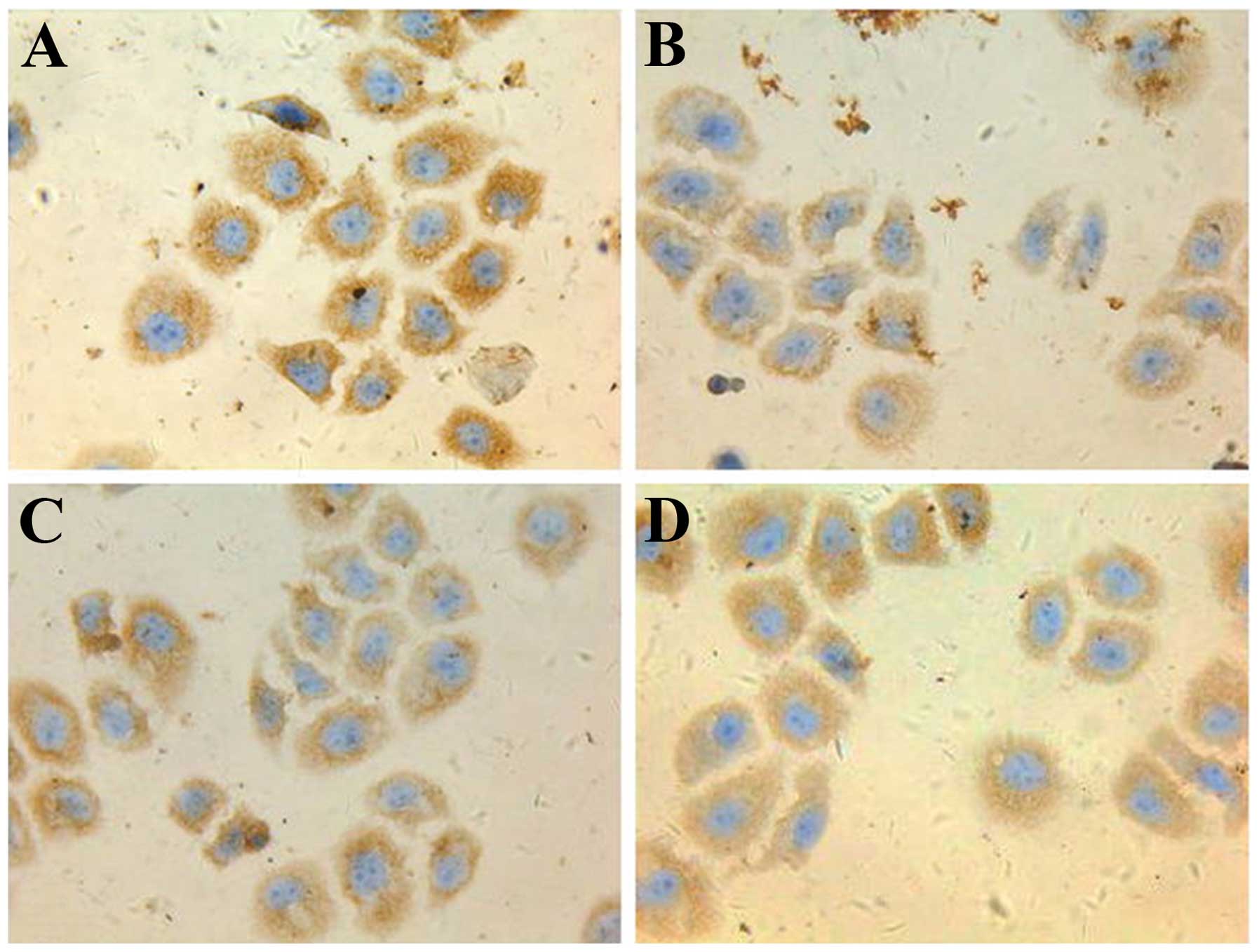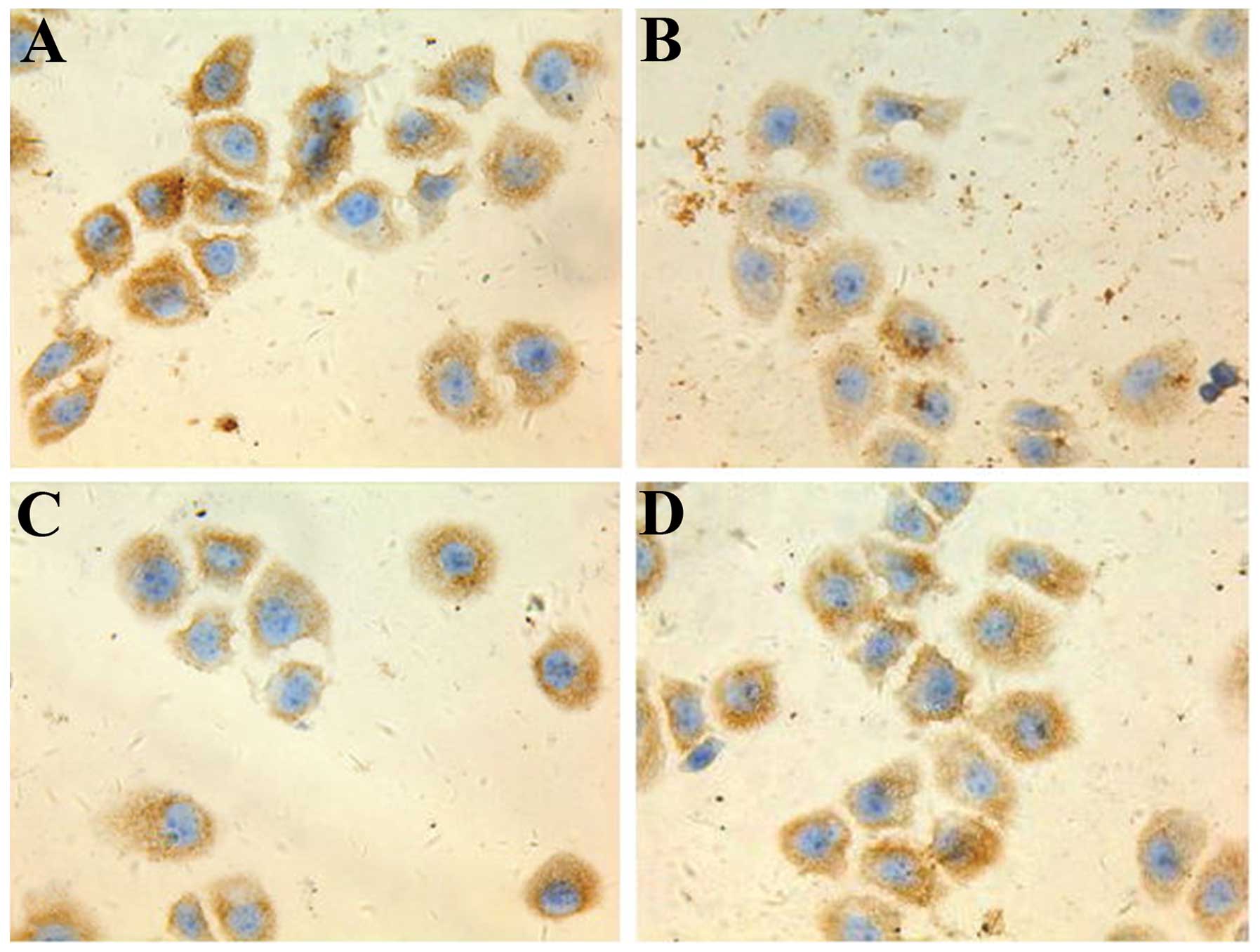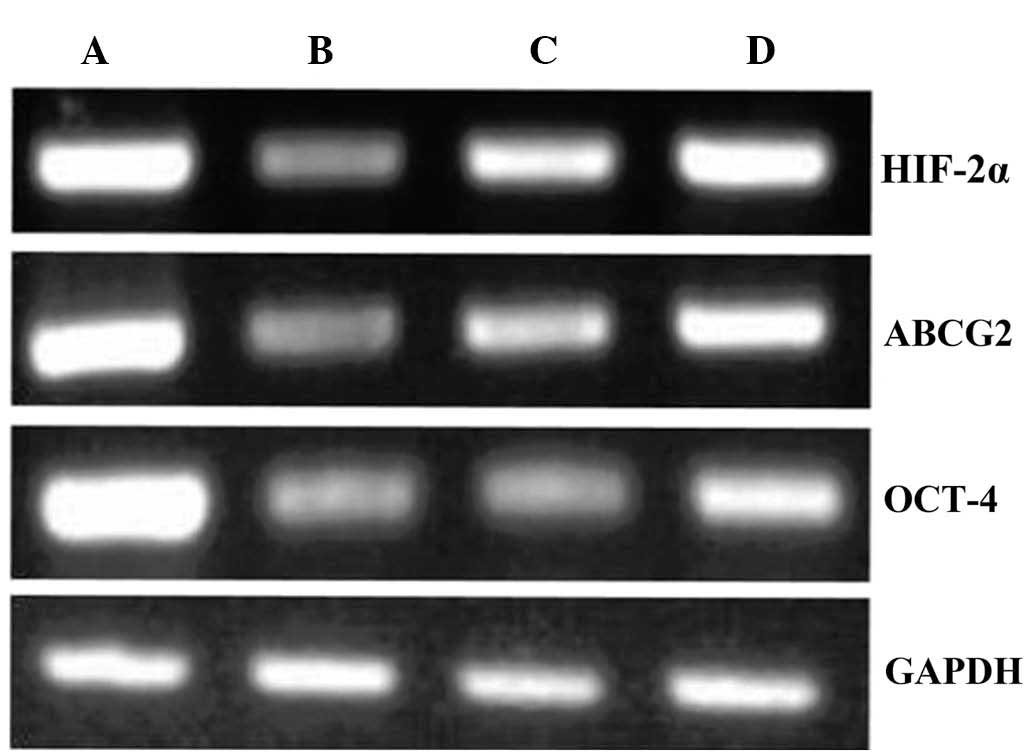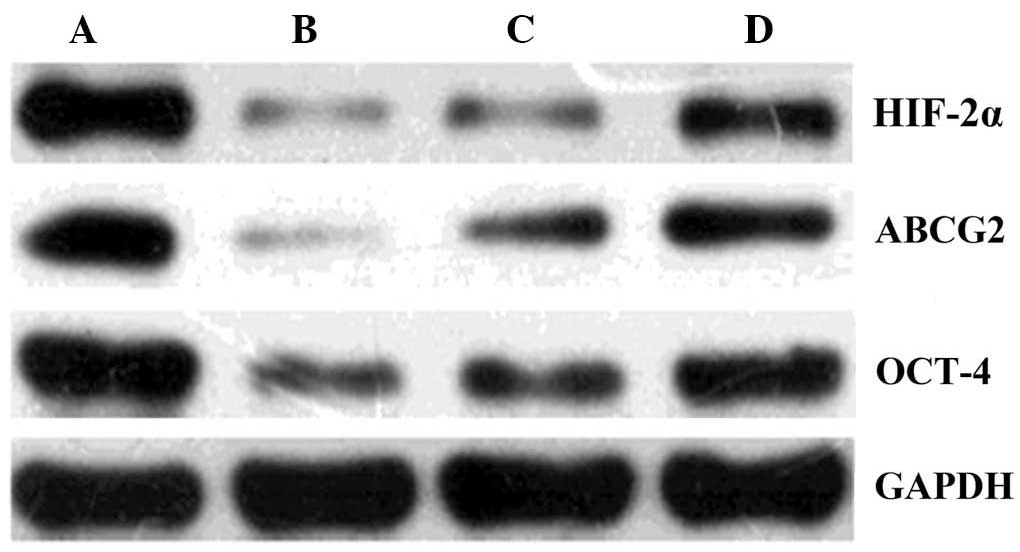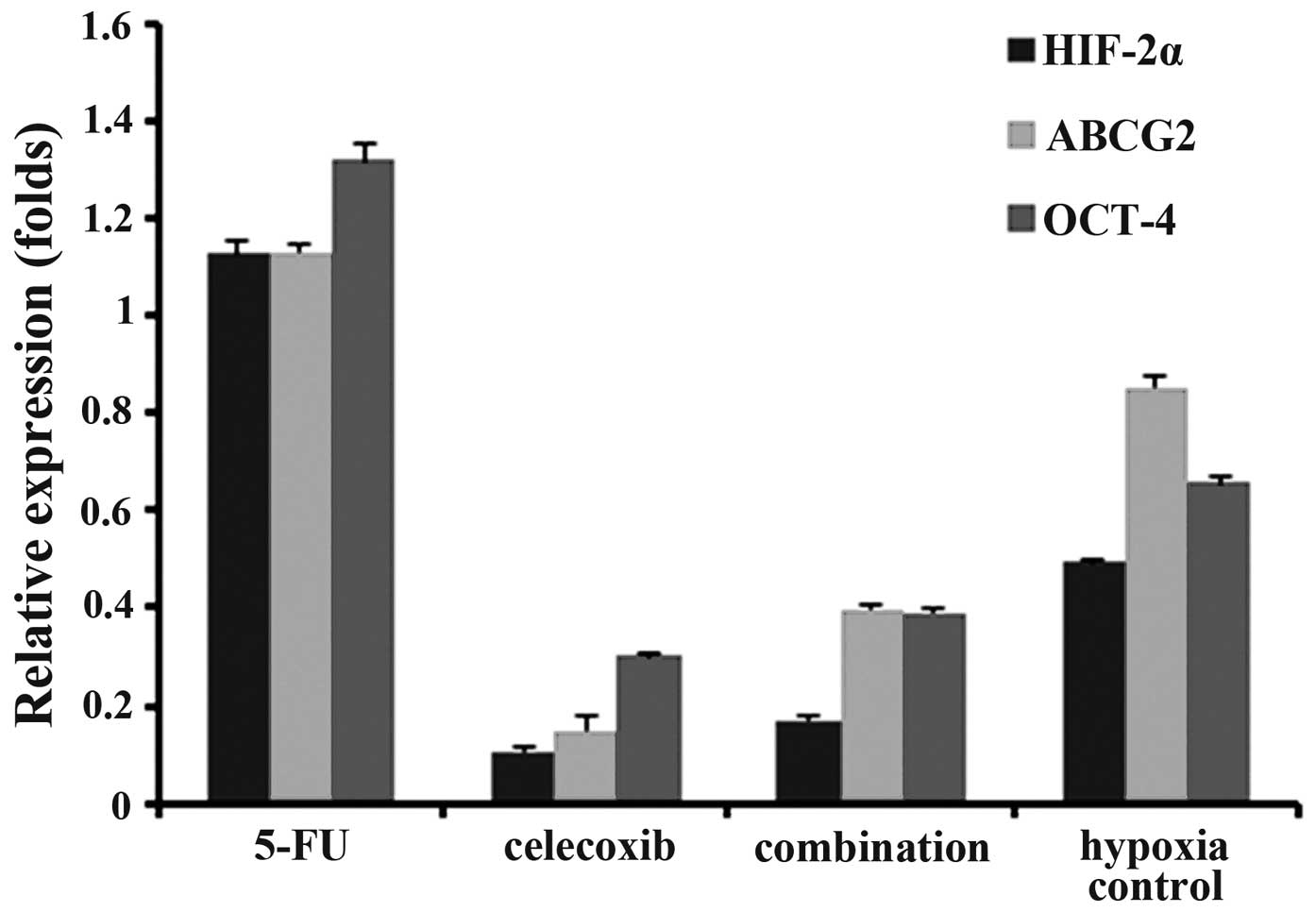Synergic effect between 5‑fluorouracil and celecoxib on hypoxic gastric cancer cells
Corrigendum in: /10.3892/mmr.2021.12332
- Authors:
- Published online on: October 27, 2014 https://doi.org/10.3892/mmr.2014.2783
- Pages: 1160-1166
Abstract
Introduction
Gastric cancer is a prevalent type of cancer with high mortality rates throughout the world, which is often diagnosed at an advanced stage (1,2). The five-year survival rate was reported to be 70–75% for stage I disease, which drops to 35% for stage II (2). Numerous efforts have been taken to improve therapies and survival; at present, chemotherapy is one of the primary treatments for gastric cancer (3). However, chemotherapy treatment is not always effective; hypoxia, a characteristic of solid tumors, including gastric cancer, has been reported to induce chemotherapy resistance (4).
5-fluorouracil (5-FU) is an antimetabolite chemothrapeutic drug which targets thymidylate synthase, blocking the transformation of deoxy-uridine monophosphate into deoxy-thymidine acid. This results in cell death via decreased DNA synthesis and S-phase arrest (5). Clinical trials showed that regimens containing 5-FU improved the survival rate of gastric cancer patients; however, local treatment failure and distant metastases still occur (3,6). Previous studies have demonstrated that hypoxic conditions induced cancer cell resistance to 5-FU treatment in vitro (7,8).
Celecoxib is a non-steroidal anti-inflammatory drug (NSAID) and a selective cyclooxygenase (COX)-2 inhibitor with anti-inflammatory and analgesic effects (9). Previous studies indicated that celecoxib may have a promising novel use in the treatment of cancer; however, its mechanism of action remains to be elucidated (10–12).
The aim of the present study was to assess the effects of celecoxib on hypoxic gastric cancer SGC7901 cells and determine whether celecoxib reduced the hypoxia-induced resistance of these cells to 5-FU. Furthermore, the present study aimed to elucidate the underlying mechanisms of action in order to improve the treatment of gastric cancer and increase the survival rate of patients.
Materials and methods
Materials
Human gastric cancer cells SGC7901 (Shandong Academy of Sciences, Jinan, China)and cobalt chloride (CoCl2) were provided by Professor Feng from the Affiliated Hospital of Weifang Medical University (Weifang, China). The cells tested negative for mycoplasmic infection. 5-FU was obtained from Zhenguo Pharmaceutical Co., Ltd. (Jiangsu, China). RPMI 1640 medium was purchased from Gibco-BRL (Carlsbad, CA, USA). MTT kits were purchased from Sigma (St Louis, MO, USA). Fetal bovine serum (FBS) was obtained from Hyclone (Thermo Fisher Scientific, Waltham, MA, USA). Rabbit anti-hypoxia-inducible factor (HIF)-2α, anti-octamer binding protein (Oct)-4 and anti-adenosine triphosphate-binding cassette sub-family G member 2 (ABCG2) antibodies and immunohistochemical kits were for purchased from Abcam (Cambridge, MA, USA). TRIzol® reagent was purchased from Invitrogen Life Technologies (Carlsbad, CA, USA). Oligo-deoxy-thymine(dT), Moloney murine leukemia virus (M-MLV) reverse transcriptase, 5× reverse transcription buffer and 10× polymerase chain reaction (PCR) buffer were obtained from Fermentas (Waltham, MA, USA). A protein extraction kit was purchased from Biyuntian Biotech, Co. (Shanghai, China). Finally, the western blot enhanced chemiluminescence (ECL) reagent kit was obtained from Thermo Fisher Scientific (Waltham, MA, USA).
Cell culture
SGC7901 cells were inoculated in RPMI 1640 medium containing FBS (100 ml/l), penicillin and streptomycin (105 U/l). Cells were subcultured regularly at 37°C in a 5% CO2 incubator. The chemical hypoxia-inducing agent CoCl2 (150 μmol/l) was used to simulate the hypoxic microenvironment of solid tumors.
Proliferation inhibition rate
The proliferation inhibition rates of different concentrations of 5-FU and celecoxib in gastric cancer cells under hypoxia were determined by MTT assay. Cells in the logarithmic growth phase were inoculated in 96-well culture plates at a cell density of 2×104/l (200 μl). Cells were divided into four groups: The hypoxia control group, 5-FU group, celecoxib group and 5-FU/celecoxib combination group. CoCl2 was used to simulate a hypoxic microenvironment following the cells becoming adherent. The hypoxic control group was not treated with any drug. Cells in the 5-FU group were exposed to numerous concentrations of 5-FU (25, 50, 100 and 200 mg/l). The celecoxib group was exposed to different concentrations of celecoxib (50, 100, 200 and 300 μmol/l). Cells were cultured for 24, 48 or 72 h at 37°C in a 5% CO2 incubator. Optical density (OD) for each well was measured using a microplate reader (Bio-rad 680; Bio-rad Laboratories, Inc., Hercules, CA, USA) at 490 nm. Cell growth inhibition rates were calculated as: [(control OD-experimental OD)/control OD] ×100%. The half inhibitory concentrations (IC50) of 5-FU and celecoxib under hypoxic conditions were calculated. The 5-FU/celecoxib combination group was subjected to 5-FU and celecoxib using their respective IC50. Cell growth inhibition rates were calculated following culturing the cells for 24, 48 and 72 h at 37°C in a 5% CO2 incubator.
Immunohistochemical detection of HIF-2α, ABCG2 and Oct-4
SGC7901 cells in the logarithmic growth phase were prepared into a 4×104 cells/ml suspension (0.5 ml) and added to 24-well plates with cover glasses. Cells were separated into identical groups and subjected to identical conditions to those of the proliferation inhibition rate experiment. The cover glasses were removed following 48 h in culture. Cells were fixed using cold acetone for 10–15 min and then washed with PBS. Immunohistochemistry kits for HIF-2α, ABCG2 and Oct-4 were used according to the manufacturer’s instructions. MDA-MB-231 breast cancer cells (Shanghai Baili Biological Technology Co., Shanghai, China) were used as the positive control and PBS in place of the primary antibodies was used as the negative control. Cytoplasms stained with yellowish brown pellets indicated a positive result.
HIF-2α, ABCG2 and Oct-4 reverse transcription quantitative PCR (RT-qPCR)
Cells were grouped and subjected to identical conditions as in the proliferation inhibition rate and immunohistochemistry experiments. TRIzol® was used to extract total RNA from the cells, RNA was then dissolved in 30 μl 0.1% diethylpyrocarbonate water (Biyuntian Biotech, Co., Shanghai, China). Reverse transcription was performed in 20 μl to obtain cDNA: RNAase-free deionized water (9 μl), RNA template (2 μl), Oligo-(dT)-18 (1 μl), 5× reaction buffer (4 μl), RNase inhibitor (20 U/μl; 1 μl), dNTP mix (10 mmol/l; 2 μl), and M-MLV RT (1 μl). Reaction conditions were: 70°C for 5 min, then immediately put on ice for 5 min; 25°C for 5 min; 37°C for 60 min; and 70°C for 10 min. Samples were kept on ice if used immediately, or kept at −150°C if used later.
Primer sequences for semi-quantitative PCR were: HIF-2α forward, 5′-CTT GGA GGG TTT CAT TGC TGT GGT-3′ and reverse, 5′-GTG AAG TCA AAG ATG CTG TGT CCT-3′ (123 bp); ABCG2 forward, 5′-CCC TTA TGA TGG TGG CTT ATT C-3′ and reverse, 5′-GTG AGA TTG ACC AAC AGA CCA T-3′ (132 bp); Oct-4 forward, 5′-CCC GAA AGA GAA AGC GAA CC-3′ and reverse, 5′-CAG AAC CAC ACT CGG ACC AC-3′ (151 bp); and GAPDH forward, 5′-GCA CCA CCA ACT GCT TAG CAC-3′ and reverse, 5′-GCA GCG CCA GTA GAG GCA GG-3′ (1143 bp). PCR reaction (50 μl) was performed using cDNA template (1 μl), forward and reverse primers (1 μl each), Taq DNA polymerase (1 μl), dioxynucleotide triphosphates (2 mmol/l, 5 μl), MgCl2 (25 mmol/l, 2 μl), 10× PCR buffer (5 μl) and double distilled H2O (34 μl). Conditions were as follows: 94°C for 5 min, 94°C for 30 sec, 50°C for 30 sec and 72°C for 60 sec, for 40 cycles and then 72°C for 10 min. Fragments were separated using 1.5% agarose gel electrophoresis. The MiniLumi digital photo gel imaging system (DNR Bio-Imaging Systems Ltd., Jerusalem, Israel) and Image J 1.26t (National Institutes of Health, Bethesda, MD, USA) were used to capture images of the gels. HIF-2α, ABCG2 and Oct-4 messenger RNA (mRNA) expression was determined based on the OD value using GAPDH as reference.
Western blot analysis
Cells were grouped and treated as described above. Cells were washed twice with chilled PBS following 24 h in culture. Radio-immunoprecipitation assay cell lysis solution (Biyuntian Biotech, Co.) was added, then kept in an ice bath for 30 min. Cells were centrifuged (100 × g) for 10 min at 4°C. The supernatant was collected and stored at −70°C. Proteins (25 μg) were separated using SDS-PAGE, transferred to nitrocellulose membranes, and incubated for 2 h with 5% skimmed milk powder at 37°C. Primary rabbit anti-HIF-2α, Oct-4 and ABCG2 polyclonal antibodies (dilution 1:50) and GAPDH were added and incubated overnight at 4°C. Secondary horseradish peroxidase-labeled antibodies were added and incubated for 2 h at 37°C. The antibodies were purchased from Abcam (Cambridge, MA, USA). Blots were quantified using an ECL reagent. The ratio of the absorbance value of HIF-2α, ABCG2 and Oct-4 was determined relative to GAPDH using the digital photo gel imaging system (Image J).
Statistical analysis
SPSS 17.0 (IBM, Armonk, NY, USA) was used for data processing and analysis. Continuous data are presented as the means ± standard deviation and analyzed using a one-way analysis of variance, followed by a Dunnett’s post-hoc T3 test. P<0.05 was considered to indicate a statistically significant difference between values.
Results
5-FU and celecoxib, alone or in combination, inhibit the proliferation of hypoxic SGC7901 cells
The proliferation of hypoxic SGC7901 gastric cancer cells was significantly inhibited in a dose-dependent manner by 5-FU (Table I) and celecoxib (Table II), (P<0.05 for comparisons of all concentrations for 5-FU as well as celecoxib). Cells were in the logarithmic growth phase within 48 h following inoculation. The IC50 of 5-FU was 200 mg/l, while the IC50 of celecoxib was 100 μmol/l. The respective IC50 of 5-FU and celecoxib were used in combination for the treatment of the 5-FU/celecoxib combination group. The combination treatment inhibited cell proliferation to a greater extent at each time-point than each treatment alone (Table III).
Table IEffect of treatment time and 5-FU concentration on proliferation of SGC7901 cells under hypoxic conditions. |
Table IIEffect of treatment time and celecoxib concentration on proliferation of SGC7901 cells under hypoxic conditions. |
Table IIIInhibition ratio using half inhibitory concentrations of each drug alone or in combination. |
5-FU-treated cells express the highest levels of HIF-2α, ABCG2 and Oct-4
Following 48 h in culture, immunohistochemical analysis revealed that the expression of HIF-2α, ABCG2 and Oct-4 proteins were the highest in the 5-FU group, followed by the hypoxia control group. The celecoxib and 5-FU/celecoxib combination groups demonstrated the lowest expression of the proteins (Figs. 1–3).
HIF-2α, ABCG2 and Oct-4 expression levels are significantly reduced by celecoxib and 5-FU/celecoxib combination treatments
RT-qPCR was used to observe changes in HIF-2α, ABCG2 and Oct-4 mRNA expression in each group following 48 h in culture. HIF-2α, ABCG2 and Oct-4 expression levels were the highest in the 5-FU group, followed by the hypoxia control group, and significantly lower in the 5-FU/celecoxib combination and celecoxib groups (P<0.01) (Figs. 4 and 5).
HIF-2α, ABCG2 and Oct-4 levels by western blot
Western blot analysis was used to observe the changes in HIF-2α, ABCG2 and Oct-4 expression following 48 h in culture. HIF-2α, ABCG2 and Oct-4 expression were the highest in the 5-FU group, followed by the hypoxia control group, and significantly lower in the 5-FU/celecoxib combination and celecoxib groups (P<0.01) (Figs. 6 and 7).
Discussion
5-FU is one of the most commonly used chemotherapeutic drugs, which is also employed to test the tumor susceptibility of gastric cancer cells in vitro (7,8). The mechanism of 5-FU proceeds through inducing apoptosis via blocking DNA synthesis, which is done by restricting the progression of cells in the S phase of the cell cycle (13). However, cells have been shown to develop resistance to 5-FU, particularly solid tumor cells under hypoxic conditions (4,7,8). Therefore, determining novel strategies to overcome this resistance is of prime importance.
The present study demonstrated that celecoxib or 5-FU alone were able to inhibit gastric cancer cell growth. Of note, the combination of the two drugs had a synergistic effect, further inhibiting the growth of tumor cells. The results also revealed that the expression levels of HIF-2α, ABCG2 and Oct-4 were involved in the growth suppression of these tumor cells.
Previous studies have reported that small amounts of cancer stem cells were present in tumor tissues; these cells had an unlimited self-renewal ability and unlimited differentiation potential. Cancer stem cells are increasingly thought to be the cause of metastases and tumor recurrence as well as drug and radiation resistance (14,15). However, little is currently known about these cells and their phenotypic marker profile has not yet been defined; therefore, purification of cancer stem cells is difficult.
HIF was reported to be closely associated with a malignant phenotype, which was involved in tumor angiogenesis, invasion and metastasis as well as drug and radiation resistance (16). HIF-2α, in comparison to HIF-1α, was shown to be more closely associated with cancer stem cells and maintains the stem cell phenotype via the regulation of several associated pathways (17). ABCG2, a member of the superfamily of transport proteins, was reported to be involved in the excretion of numerous chemotherapeutic drugs from cells; therefore, high expression of ABCG2 may be a significant contributing factor in tumor multi-drug resistance (18). Studies have shown that ABCG2 expression was high in numerous cancer stem cells, and that ABCG2 was a direct target gene of HIF-2α. This therefore indicated that high expression of HIF-2α and ABCG2 may lead to the multi-drug resistance observed in tumor stem cells and hypoxic cells (19). Oct-4, a member of the Pit-Oct-Unc (POU) family of transcription factors, acts as a marker of cancer stem cell pluripotency (20,21). Covello et al (17) demonstrated that Oct-4 was also a direct target gene of HIF-2α. This therefore indicated that hypoxia may induce the retention of a stem cell phenotype in tumor cells through activation of the HIF-2α/Oct-4 pathway.
Dallas et al (22) reported a high expression of the stem cell phenotype (CD133+/CD44+) in colon cancer cell lines (HT29/5-FUR) resistant to 5-FU, therefore suggesting that the cancer stem cells resistant to 5-FU may be the source of chemotherapy resistance. A previous study showed that expression levels of HIF-2α and ABCG2 were increased when 5-FU was added to the SGC7901 gastric cancer cells under hypoxic conditions, therefore indicating that this resistance may be associated with the induction of the HIF-2α/ABCG2 pathway and promote the maintenance of the stem cell phenotype (23).
Celecoxib is a selective COX-2 inhibitor which has anti-inflammatory and analgesic effects (24). It is primarily used for the treatment of acute or chronic osteoarthritis as well as rheumatoid arthritis; in addition, celecoxib has fewer gastrointestinal side effects than other NSAIDs (9). Celecoxib was also reported to have certain anti-tumor effects (10–12). Steinbach et al (25) showed that celecoxib significantly reduced the occurrence of polyps in patients with familial adenomatous polyposis. In addition, chronic NSAID therapy may be able to reduce the risk of colon cancer by 50%, as well as the incidence of esophageal and gastric cancer (26). Studies on animals showed that celecoxib prevented and inhibited gastric cancer carcinogenesis (27,28). The results of the present study demonstrated that celecoxib inhibited the proliferation of SGC7901 gastric cancer cells. The inhibition rate of the combined 5-FU/celecoxib group was significantly increased compared with that of the 5-FU group; these results were consistent with those of a previous study using rofecoxib combined with anti-tumor drugs on gastric cancer (29).
However, the mechanism of the anti-tumor effect of NSAIDs remains to be elucidated. Previous experiments have suggested that NSAIDs induce apoptosis of tumor cells through inhibiting COX-2 activity, therefore reducing the synthesis of prostaglandin E2 (30). However, Ding et al (31) observed that the mechanism of the anti-tumor effect of celecoxib occurs prior to the deterioration of oral mucosa cells. Numerous studies have suggested that celecoxib may promote tumor cell apoptosis via COX-2-independent pathways, and its effects on apoptosis may be achieved through the regulation of genes, including p21, Fas, protein kinase B, glycogen synthase kinase 3β, forkhead homolog in rhabdomyosarcoma, caspase-9, B cell lymphoma 2/B cell lymphoma 2-associated X protein, p53 and survivin (32–35). However, further studies are required in order to elucidate the exact mechanisms underlying the effects of celecoxib in tumor cells.
In conclusion, the results of the present study demonstrated that celecoxib reduced mRNA and protein expression of HIF-2α, Oct-4 and ABCG2 in gastric cancer SGC7901 cells under hypoxic conditions. This therefore indicated that elevated expression of HIF-2α, ABCG2 and Oct-4 mRNA may lead to 5-FU resistance. Furthermore, the results showed that celecoxib increased the efficacy of 5-FU in gastric cancer by reducing 5-FU resistance, therefore indicating its potential synergic use in chemotherapy treatment. However, clinical trials are required to confirm this hypothesis.
Acknowledgements
This study was supported by the Science and Technology Innovation Foundation of Affiliated Hospital of Weifang Medical University, and by a grant from the Shandong Province Science and Technology Program (no. 2012YD18108).
References
|
Siegel R, Naishadham D and Jemal A: Cancer statistics, 2013. CA Cancer J Clin. 63:11–30. 2013. View Article : Google Scholar : PubMed/NCBI | |
|
Agboola O: Adjuvant treatment in gastric cancer. Cancer Treat Rev. 20:217–240. 1994. View Article : Google Scholar : PubMed/NCBI | |
|
Cunningham D, Allum WH, Stenning SP, et al: Perioperative chemotherapy versus surgery alone for resectable gastroesophageal cancer. N Engl J Med. 355:11–20. 2006. View Article : Google Scholar : PubMed/NCBI | |
|
Cosse JP and Michiels C: Tumour hypoxia affects the responsiveness of cancer cells to chemotherapy and promotes cancer progression. Anticancer Agents Med Chem. 8:790–797. 2008. View Article : Google Scholar : PubMed/NCBI | |
|
Longley DB, Harkin DP and Johnston PG: 5-fluorouracil: mechanisms of action and clinical strategies. Nat Rev Cancer. 3:330–338. 2003. View Article : Google Scholar : PubMed/NCBI | |
|
Griffiths EA, Pritchard SA, Welch IM, Price PM and West CM: Is the hypoxia-inducible factor pathway important in gastric cancer? Eur J Cancer. 41:2792–2805. 2005. View Article : Google Scholar : PubMed/NCBI | |
|
Liu L, Ning X, Sun L, et al: Hypoxia-inducible factor-1 alpha contributes to hypoxia-induced chemoresistance in gastric cancer. Cancer Sci. 99:121–128. 2008. | |
|
Kang HC, Kim IJ, Park JH, Shin Y, Ku JL, Jung MS, Yoo BC, Kim HK and Park JG: Identification of genes with differential expression in acquired drug-resistant gastric cancer cells using high-density oligonucleotide microarrays. Clin Cancer Res. 10(1 Pt 1): 272–284. 2004. View Article : Google Scholar : PubMed/NCBI | |
|
Mathew ST, Devi SG, Prasanth VV and Vinod B: Efficacy and safety of COX-2 inhibitors in the clinical management of arthritis: Mini review. ISRN Pharmacol. 2011:4802912011. View Article : Google Scholar : PubMed/NCBI | |
|
Dannenberg AJ and Subbaramaiah K: Targeting cyclooxygenase-2 in human neoplasia: rationale and promise. Cancer Cell. 4:431–436. 2003. View Article : Google Scholar | |
|
Schönthal AH: Direct non-cyclooxygenase-2 targets of celecoxib and their potential relevance for cancer therapy. Br J Cancer. 97:1465–1468. 2007. View Article : Google Scholar : PubMed/NCBI | |
|
Chuang HC, Kardosh A, Gaffney KJ, Petasis NA and Schönthal AH: COX-2 inhibition is neither necessary nor sufficient for celecoxib to suppress tumor cell proliferation and focus formation in vitro. Mol Cancer. 7:382008. View Article : Google Scholar : PubMed/NCBI | |
|
Yoshida K, Yamaguchi K, Osada S, Kawaguchi Y, Takahashi T, Sakashita F and Tanaka Y: Challenge for a better combination with basic evidence. Int J Clin Oncol. 13:212–219. 2008. View Article : Google Scholar : PubMed/NCBI | |
|
Reya T, Morrison SJ, Clarke MF and Weissman IL: Stem cells, cancer, and cancer stem cells. Nature. 414:105–111. 2001. View Article : Google Scholar : PubMed/NCBI | |
|
Jordan CT, Guzman ML and Noble M: Cancer stem cells. N Engl J Med. 355:1253–1261. 2006. View Article : Google Scholar : PubMed/NCBI | |
|
Mayer A and Vaupel P: Hypoxia, lactate accumulation, and acidosis: siblings or accomplices driving tumor progression and resistance to therapy? Adv Exp Med Biol. 789:203–209. 2013. View Article : Google Scholar : PubMed/NCBI | |
|
Covello KL, Kehler J, Yu H, Gordan JD, Arsham AM, Hu CJ, Labosky PA, Simon MC and Keith B: HIF-2alpha regulates Oct-4: effects of hypoxia on stem cell function, embryonic development, and tumor growth. Genes Dev. 20:557–570. 2006. View Article : Google Scholar : PubMed/NCBI | |
|
Hu L, McArthur C and Jaffe RB: Ovarian cancer stem-like side-population cells are tumourigenic and chemoresistant. Br J Cancer. 102:1276–1283. 2010. View Article : Google Scholar : PubMed/NCBI | |
|
Martin CM, Ferdous A, Gallardo T, Humphries C, Sadek H, Caprioli A, Garcia JA, Szweda LI, Garry MG and Garry DJ: Hypoxia-inducible factor-2alpha transactivates Abcg2 and promotes cytoprotection in cardiac side population cells. Circ Res. 102:1075–1081. 2008. View Article : Google Scholar : PubMed/NCBI | |
|
Nichols J, Zevnik B, Anastassiadis K, Niwa H, Klewe-Nebenius D, Chambers I, Schöler H and Smith A: Formation of pluripotent stem cells in the mammalian embryo depends on the POU transcription factor Oct4. Cell. 95:379–391. 1998. View Article : Google Scholar : PubMed/NCBI | |
|
Tai MH, Chang CC, Kiupel M, Webster JD, Olson LK and Trosko JE: Oct4 expression in adult human stem cells: evidence in support of the stem cell theory of carcinogenesis. Carcinogenesis. 26:495–502. 2005. View Article : Google Scholar | |
|
Dallas NA, Xia L, Fan F, et al: Chemoresistant colorectal cancer cells, the cancer stem cell phenotype, and increased sensitivity to insulin-like growth factor-I receptor inhibition. Cancer Res. 69:1951–1957. 2009. View Article : Google Scholar : PubMed/NCBI | |
|
Zhang XQ, Feng YG, Wu MY, Bai HX and Wang XY: The effect of 5-Fu on the ratio of SP cells and the expression of HIF-2α and ABCG2 in gastric cancer SGC7901 cell line under hypoxia. World Chinese Journal of Digestology. 20:1813–1818. 2012. | |
|
Rosas C, Sinning M, Ferreira A, Fuenzalida M and Lemus D: Celecoxib decreases growth and angiogenesis and promotes apoptosis in a tumor cell line resistant to chemotherapy. Biol Res. 47:272014. View Article : Google Scholar : PubMed/NCBI | |
|
Steinbach G, Lynch PM, Phillips RK, et al: The effect of celecoxib, a cyclooxygenase-2 inhibitor, in familial adenomatous polyposis. N Engl J Med. 342:1946–1952. 2000. View Article : Google Scholar : PubMed/NCBI | |
|
Li M, Lotan R, Levin B, Tahara E, Lippman SM and Xu XC: Aspirin induction of apoptosis in esophageal cancer: a potential for chemoprevention. Cancer Epidemiol Biomarkers Prev. 9:545–549. 2000.PubMed/NCBI | |
|
Kuo CH, Hu HM, Tsai PY, et al: Short-term celecoxib intervention is a safe and effective chemopreventive for gastric carcinogenesis based on a Mongolian gerbil model. World J Gastroenterol. 15:4907–4914. 2009. View Article : Google Scholar : PubMed/NCBI | |
|
Rocha FT, Lourenço LG, Jucá MJ, Costa V and Leal AT: Chemoprevention by celecoxib in reflux-induced gastric adenocarcinoma in Wistar rats that underwent gastrojejunostomy. Acta Cir Bras. 24:189–194. 2009. View Article : Google Scholar : PubMed/NCBI | |
|
Tang C, Liu C, Zhou X and Wang C: Enhanced inhibitive effects of combination of rofecoxib and octreotide on the growth of human gastric cancer. Int J Cancer. 112:470–474. 2004. View Article : Google Scholar : PubMed/NCBI | |
|
Dandekar DS, Lopez M, Carey RI and Lokeshwar BL: Cyclooxygenase-2 inhibitor celecoxib augments chemotherapeutic drug-induced apoptosis by enhancing activation of caspase-3 and -9 in prostate cancer cells. Int J Cancer. 115:484–492. 2005. View Article : Google Scholar : PubMed/NCBI | |
|
Ding H, Han C, Zhu J, Chen CS and D’Ambrosio SM: Celecoxib derivatives induce apoptosis via the disruption of mitochondrial membrane potential and activation of caspase 9. Int J Cancer. 113:803–810. 2005. View Article : Google Scholar | |
|
Kim N, Kim CH, Ahn DW, et al: Anti-gastric cancer effects of celecoxib, a selective COX-2 inhibitor, through inhibition of Akt signaling. J Gastroenterol Hepatol. 24:480–487. 2009. View Article : Google Scholar | |
|
Swamy MV, Herzog CR and Rao CV: Inhibition of COX-2 in colon cancer cell lines by celecoxib increases the nuclear localization of active p53. Cancer Res. 63:5239–5242. 2003.PubMed/NCBI | |
|
Erkinheimo TL, Lassus H, Finne P, van Rees BP, Leminen A, Ylikorkala O, Haglund C, Butzow R and Ristimäki A: Elevated cyclooxygenase-2 expression is associated with alteredexpression of p53 and SMAD4, amplification of HER-2/neu, and poor outcome in serous ovarian carcinoma. Clin Cancer Res. 10:538–545. 2004. View Article : Google Scholar : PubMed/NCBI | |
|
Krysan K, Merchant FH, Zhu L, et al: COX-2-dependent stabilization of survivin in non-small cell lung cancer. FASEB J. 18:206–208. 2004. |



